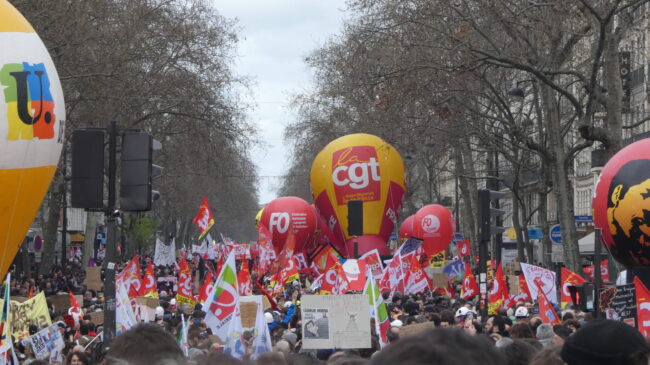Travel During the Paris Protests: What’s it Really Like in the City?

You’ve seen the images on TV. Street protests turn violent in France. Shop windows smashed, objects set on fire. The trash has piled up on the capital’s sidewalks and in the streets. Does this portray an alarmist view of the situation? What’s really going on? And is it safe to travel to Paris right now?
First, a little background. A series of strikes and manifestations, or street demonstrations, has taken place regularly against the government’s planned pension reform over the last few months. During his presidential campaign, President Macron had made a campaign promise to raise the retirement age from 62 to 64 — something he claims is vital to preserve France’s “share-out” system since people are living longer. (Other alternatives would be: increasing the contributions from those in the workforce, or cutting the value of pensions.) Yet the reform is unpopular. And when the legislation went to the National Assembly on March 16, Prime Minister Elisabeth Borne invoked a special constitutional power called L’article 49.3, which avoided a vote in the lower chamber— where they wouldn’t have a majority— to push through the reform as law. This was the 100th time the article has been used since the founding of the Fifth Republic.
Though the move was legal, it has only increased French anger at what is seen as an undemocratic process. The French who take to the streets— in a long tradition of protests— are doing so because they feel it’s the only way to make their voices heard. With rising food prices and the decline of purchasing power, the pension reform is the straw that broke the camel’s back. Among those we’ve spoken with on the streets, the perception is that the president is not listening.

L’Assemblée nationale. Photo credit: Dinkum / Wikimedia commons
What and where are the street protests?
Tuesday, March 28th was the “10ème journée de mobilisation,” or the 10th day of nationwide demonstrations. According to the Ministry of the Interior, 740,000 people gathered in France, including 93,000 in Paris. The unions claimed a higher number. The first such day of mobilization took place on January 19. These street demonstrations are announced in advance and follow specific routes, also announced in advance, usually including Bastille, Nation, place de la République and/or place d’Italie. Mostly these protests are peaceful. The unions will wave their flags and signs, play music, and often have trucks with entertainment (much like a parade). Check out this photo essay we just published to get a sense of what these demonstrations look like.
The images you saw on the news? Last Thursday night after the street protest, the manif’ was infiltrated by violent casseurs, or anarchists, who destroyed private property and set fires. A number of arrests were made by the police. There’s no place for this kind of violence, and it angers many of the protestors who are trying to express themselves peacefully. It also turns public opinion against the demonstrators.
The unions have now called for the next journée de mobilisation (the 11th) to take place on Thursday, April 6.

Demonstrators flying flags and balloons of various unions in Paris on 23 March. Photo credit: Rémi Simonnin / Wikimedia commons
Often the Paris metro system is affected during the demonstration days. This only happens if members of the RATP, or Paris public transport authority, vote to go on strike. Metros and buses still run, but less frequently. The driverless lines, no. 1 and 14, still operate at their normal frequency.
Need to know: Bus routes can be altered or stopped altogether, depending on the protest route. In general, the RER suburban lines are more affected than the metro. The RATP gives real-time information about the closures on their official website and app.
For those Parisians not participating in the demonstrations, it’s “life as usual.” Work, errands to the store, school pick-up, restaurant dinners with friends. Paris is a walkable city, and biking has become more popular, so we find ways to get to your meetings.
It’s easy to avoid the street protests altogether, depending on what neighborhood you’re in. For example, the left bank districts are generally not as affected (though there was a demonstration route near Place Denfert-Rochereau and Place d’Italie a few weeks ago).

Paris- Charles-de-Gaulle airport, aerial view. © Paris Tourist Office/ JOUANNEAUX, Jean-Marc pour Aéroports de Paris
What about the airports and train stations?
This depends whether the staff (such as air traffic controllers) decide to go on strike. For example, at Orly airport this can reach a cancellation of 30% of flights. International long-haul flights are generally not affected. This past Tuesday during the demonstration day, the Orly bus was operating as usual between Orly airport and Place Denfert-Rochereau. The RER B from CDG airport can be affected, in which case we recommend taking a G7 taxi. The taxi prices from the airport are fixed by the government.
Likewise, SNCF, the French national rail company, has been canceling select trains on strike days. Know that major cities are still being served and that people are still traveling by rail during this time.

Louvre Pyramid in Paris. © Pixabay at Pexels
Do monuments and museums close on demonstration days?
This also depends on whether the staff decide to go on strike, or whether there’s not enough personnel to manage the site due to public transportation issues. This doesn’t happen during each demonstration day. If there are going to be closures, announcements are made via the website or social media channels. For example, The Eiffel Tower, Louvre, and Chateau de Versailles were closed during the last strike day on Tuesday.
Note: there are so many different museums in Paris that there is always *something* open. See our article “Choose Your Muse: Match Your Personality to a Paris Museum” for a options.
And restaurants?
We have been dining as usual in Paris restaurants. None of our reservations have been canceled.
🚮🇫🇷 Insolite : l’artiste urbain Bisk transforme les tas monstres de poubelles à #Paris, en poubelles monstres. (Le Monde) pic.twitter.com/HIkjkJdJE7
— Mediavenir (@Mediavenir) March 24, 2023
What about the trash? Is it as bad as it looks?
Paris is no stranger to strikes by the trash collectors, but the latest may be the worst in recent memory. Mountains have trash have been accumulating on the streets and sidewalks. Building managers have even advised residents to keep the trash in their apartments. However some neighborhoods have not been affected at all. For example, the 13th arrondissement trash collection is overseen by a private company, and so the streets are clean — in stark contrast with the neighboring 14th arrondissement where it’s only been collected a few times in the last three weeks. But there’s good news: The CGT union announced the end of the strike today, and trash trucks were seen resuming their routes in the city. Note that access to one of the trash incinerators in the suburbs was still blocked by protestors.
That’s not to say that the strikes won’t resume again. Some union representatives are threatening to start up again as soon as possible, and continue their action until the pension reform has been withdrawn. Meanwhile Prime Minister Borne has extended an offer to the unions to meet at the negotiating table.
Have other questions? We’ll be happy to help. Just leave them in the comment section below.
Lead photo credit : Demonstrators on the July Column. Photo credit: Roland Godefroy / Wikimedia commons



REPLY